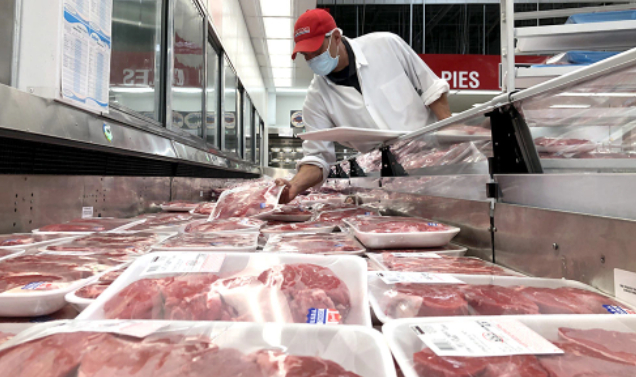November 28, 2025 | 03:53 GMT +7
November 28, 2025 | 03:53 GMT +7
Hotline: 0913.378.918
November 28, 2025 | 03:53 GMT +7
Hotline: 0913.378.918

The USDA is responsible, in part, for ensuring that the food that ends up on our plates is safe, regulated and standardized. Photo: The Hill
But a recent article in the academic journal Science raises troubling questions about how much American consumers can trust United States Department of Agriculture (USDA) approved meat labels — ultimately presenting us with a consumer trust crisis with public health consequences.
The USDA mission statement outlines that the agency provides “leadership on food, agriculture, natural resources, rural development, nutrition, and related issues based on public policy, the best available science, and effective management.”
The USDA is responsible, in part, for ensuring that the food that ends up on our plates is safe, regulated and standardized. That is a tall order to fill, which is why the second part of the mission statement is so critical: how the agency helps govern what’s in our food is “based on public policy, the best available science, and effective management.”
Today’s “best available science” tells us that excessive misuse of antibiotics in livestock production is significantly contributing to the development of antimicrobial resistance in humans. The growing market for meat that is “raised without antibiotics” has the potential to help mitigate this problem, but only if the labels are trustworthy.
The recent Science article, “Policy Reforms for Antibiotic Use Claims in Livestock” presents empirical evidence that a material portion of beef products currently being marketed as “raised without antibiotics” label is from cattle that were in fact treated with antibiotics. What they found was shocking: 15 percent of all cattle slaughtered at the facility came from a feedlot with at least one animal testing positive for antibiotics.
While disappointing and concerning, this doesn’t come as a surprise. There is an apparent absence of testing for “raised without antibiotics” labels approved by USDA’s Food Safety Inspection Service (FSIS), an example of regulatory failure of U.S. government agencies to track antibiotic use in food animal production, restrict that use, collect information on the amount and location of antibiotics used in food animal production, and understand the rates of human infections caused by it.
Routine use of antibiotics in animal production began in the late 1940s when it was discovered, somewhat accidentally, that low levels of daily antibiotics administered in poultry feed aided in accelerated growth. The practice was enhanced in poultry production and expanded for use in other species, including beef cattle and swine. Efforts by the FDA, the federal agency responsible for the contents of animal feed and use of antibiotics in food animal production, were thwarted when the food animal industry lobbied Congress to stop FDA’s review of antibiotic use.
In 2008, President Obama’s incoming FDA Administrator Dr. Margaret Hamburg, said that we should approach the spread of antibiotic-resistant bacteria as if “our hair was on fire.” Shortly after, a recommendation from the Pew Commission on Industrial Farm Animal Production — a commission at the Johns Hopkins Center for a Livable Future charged with developing consensus recommendations to address the public health, environmental, animal welfare and rural community problems caused by large scale animal operations on which I led — urged the “phase out and ban of antimicrobials for nontherapeutic use in food animals.”
Since 2009, FDA has made voluntary recommendations that have been ineffective in stopping the use of nontherapeutic, medically important antibiotics. While there are some restrictions — including the ban of antibiotics for growth promotion, they are still allowed for disease prevention. But because the use of antibiotics are for disease prevention is indistinguishable from growth promotion uses, this restriction is meaningless and exactly what the industry wants. These serial failures have led consumers who wish to buy meat raised without antibiotics to rely on USDA certifications like “Raised Without Antibiotics,” “No Antibiotics Ever” or “No Antibiotics Added.” This new research seriously questions, even destroys, the credibility and integrity of the USDA labeling system and severely damages consumer trust.
The Centers for Disease Control and Prevention (CDC) estimates that 2.8 million resistant infections and 35,000 deaths occur annually in the United States. Most observers believe that is an undercount since reporting is so lax. Even at those estimates — that would mean there have been approximately 39.2 billion infections and 490,000 deaths from resistant infections since the Pew Commission report was released 14 years ago. With approximately 74 percent of medically important antibiotics sold in the U.S. being used in livestock, use and regulation must change. It’s time the USDA lives up to a critical element of its mission statement — effective management. And it must happen now.
(The Hill)

(VAN) A new study reveals how the simultaneous effects of ocean acidification, salinity and loss of oxygen are making the world more fragile.

(VAN) Hopes are growing that the creation of the first 3D turkey gut model could be a turning point in the battle against the virulent blackhead disease.

(VAN) Tyson, America’s biggest meat supplier, plans to shutter one of its largest beef processing plants as the industry continues to struggle with low cattle supplies and political pressure from Washington.

(VAN) New FAO study shows how digital solutions are empowering farmers and fishers to prevent losses and build resilient agrifood systems.

(VAN) Brazil's COP30 presidency pushed through a compromise climate deal on Saturday that would boost finance for poor nations coping with global warming but that omitted any mention of the fossil fuels driving it.

(VAN) Poultry farmers in the UK have been warned that they could face one of the worst winters yet for bird flu.

(VAN) Prices of main-crop paddy have risen sharply, with jasmine rice hitting 16,100 baht per tonne — the highest level in years.